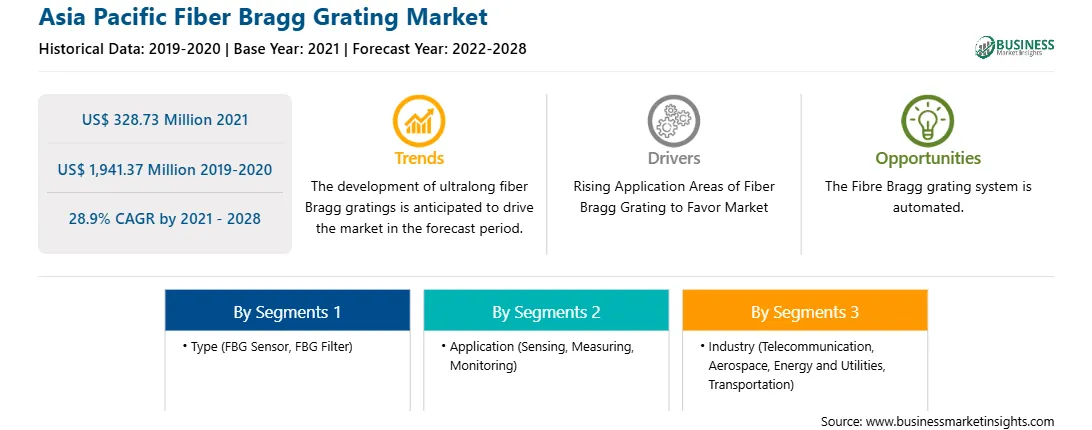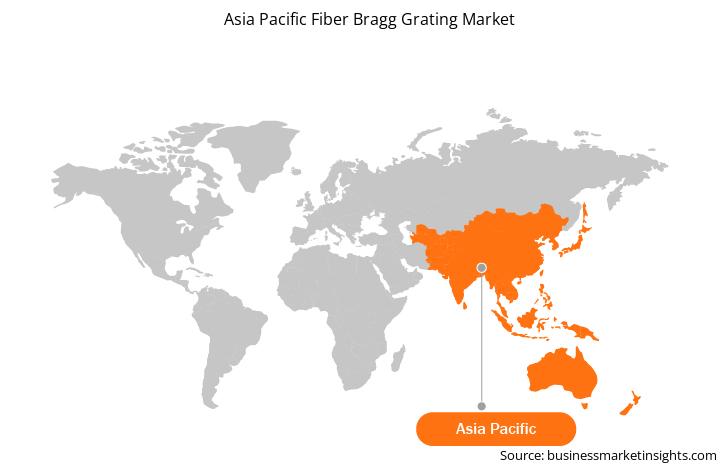APAC is home to numerous SMEs, which capitalize heavily on advanced technologies, and this factor is favoring the fiber bragg grating market in the region. The continuously growing economies in this region are China, India, Japan, South Korea, Singapore, Taiwan, and Malaysia. Manufacturers have a big opportunity to expand their business by tapping into different geographies. As one of the world's fastest-growing economies, Asia Pacific has enormous growth potential. In comparison with other regions, this area has a higher population density. As a result, there has been a surge in initiatives to improve communication through fiber lines. This factor is boosting the growth of the fiber bragg grating market in the region.
APAC is one of the crucial regions for the market's future growth, owing to many developing countries such as China and India. These countries have a high industrial presence, a positive economic outlook, and favorable government policies, which provide immense growth opportunities for the FBG market. However, the COVID-19 outbreak has caused massive disruptions in the growth of various sectors of the APAC region. For instance, according to the National Statistical Office (NSO) data, the manufacturing sector output declined by 20.6% in May 2020 compared to a growth of 3.1% in May 2019 due to travel restrictions, closing of manufacturing plants, unavailability of raw materials, and workforce. However, with manufacturing plants resuming their operations, the production of FBG filters and sensors will rise, eventually boosting the growth of the fiber bragg grating market in APAC.

Strategic insights for the Asia Pacific Fiber Bragg Grating provides data-driven analysis of the industry landscape, including current trends, key players, and regional nuances. These insights offer actionable recommendations, enabling readers to differentiate themselves from competitors by identifying untapped segments or developing unique value propositions. Leveraging data analytics, these insights help industry players anticipate the market shifts, whether investors, manufacturers, or other stakeholders. A future-oriented perspective is essential, helping stakeholders anticipate market shifts and position themselves for long-term success in this dynamic region. Ultimately, effective strategic insights empower readers to make informed decisions that drive profitability and achieve their business objectives within the market.

| Report Attribute | Details |
|---|---|
| Market size in 2021 | US$ 328.73 Million |
| Market Size by 2028 | US$ 1,941.37 Million |
| Global CAGR (2021 - 2028) | 28.9% |
| Historical Data | 2019-2020 |
| Forecast period | 2022-2028 |
| Segments Covered |
By Type
|
| Regions and Countries Covered | Asia-Pacific
|
| Market leaders and key company profiles |
The geographic scope of the Asia Pacific Fiber Bragg Grating refers to the specific areas in which a business operates and competes. Understanding local distinctions, such as diverse consumer preferences (e.g., demand for specific plug types or battery backup durations), varying economic conditions, and regulatory environments, is crucial for tailoring strategies to specific markets. Businesses can expand their reach by identifying underserved areas or adapting their offerings to meet local demands. A clear market focus allows for more effective resource allocation, targeted marketing campaigns, and better positioning against local competitors, ultimately driving growth in those targeted areas.

The fiber bragg grating market in APAC is expected to grow from US$ 328.73 million in 2021 to US$ 1,941.37 million by 2028; it is estimated to grow at a CAGR of 28.9% from 2021 to 2028. Increased usage of fiber bragg grating in the telecommunication industry for fault monitoring in fiber to the home (FTTH) networks, as well as to confirm or locate connectivity faults in the network, is one of the major drivers for the fiber bragg grating market in the region. In addition, due to fiber bragg grating's capacity to detect characteristics such as temperature and pressure, there is an increasing demand from sectors such as aircraft, construction, and oil & gas. The fiber bragg grating technique has several benefits over standard grating technology, including immunity to electromagnetic interference, high sensitivity, lightweight, and low thermal conductivity. The major players operating in the fiber bragg grating market in APAC include Wuhan Ligong Guangke, FBG KOREA, and Alnair Labs Corporation. Further, the ongoing COVID-19 crisis is anticipated to cause huge disruptions in the growth of various industries in APAC. Commercial and consumer electronics sectors would witness a downfall in their growth amid this pandemic due to a disturbed supply chain of components; this would also impact fiber bragg grating. However, the impact will continue for a short term since various Asian countries are gradually reopening their businesses, while in China and South Korea, commercial offices have already resumed their operations; thus, this factor would boost the growth of the fiber bragg grating market in mid-2021 onward.
APAC fiber bragg grating market is segmented into type, application, industry, and country. Based on type, the APAC fiber bragg grating market is segmented into FBG sensor and FBG filter. The FBG sensor segment held the largest market share in 2020. Based on application, the APAC fiber bragg grating market is segmented into sensing, measuring, and monitoring. The sensing segment held the largest market share in 2020. Based on industry, the market is segmented into telecommunication, transportation, energy and utilities, aerospace, and others. The telecommunication industry dominates the market in 2020. Based on country, the APAC fiber bragg grating market is segmented into Australia, China, India, Japan, South Korea, and rest of APAC. China held the largest market share in 2020.
A few major primary and secondary sources referred to for preparing this report on the fiber bragg grating market in APAC are company websites, annual reports, financial reports, national government documents, and statistical database, among others. Major companies listed in the report are Alnair Labs Corporation, AOS GmbH. FBGS Technologies GmbH, HBM Fibersensing S.A, Ixblue Photonics, Micron Optics (Luna Innovations), Proximion AB, and Technica.
The Asia Pacific Fiber Bragg Grating Market is valued at US$ 328.73 Million in 2021, it is projected to reach US$ 1,941.37 Million by 2028.
As per our report Asia Pacific Fiber Bragg Grating Market, the market size is valued at US$ 328.73 Million in 2021, projecting it to reach US$ 1,941.37 Million by 2028. This translates to a CAGR of approximately 28.9% during the forecast period.
The Asia Pacific Fiber Bragg Grating Market report typically cover these key segments-
The historic period, base year, and forecast period can vary slightly depending on the specific market research report. However, for the Asia Pacific Fiber Bragg Grating Market report:
The Asia Pacific Fiber Bragg Grating Market is populated by several key players, each contributing to its growth and innovation. Some of the major players include:
The Asia Pacific Fiber Bragg Grating Market report is valuable for diverse stakeholders, including:
Essentially, anyone involved in or considering involvement in the Asia Pacific Fiber Bragg Grating Market value chain can benefit from the information contained in a comprehensive market report.